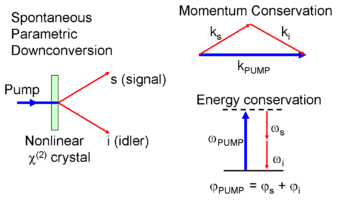
Spontaneous parametric down conversion
Encyclopedia

Quantum optics
Quantum optics is a field of research in physics, dealing with the application of quantum mechanics to phenomena involving light and its interactions with matter.- History of quantum optics :...
, used especially as a source of entangled
Quantum entanglement
Quantum entanglement occurs when electrons, molecules even as large as "buckyballs", photons, etc., interact physically and then become separated; the type of interaction is such that each resulting member of a pair is properly described by the same quantum mechanical description , which is...
photon pairs, and of single photons.
Basic process
A nonlinear crystalNonlinear optics
Nonlinear optics is the branch of optics that describes the behavior of light in nonlinear media, that is, media in which the dielectric polarization P responds nonlinearly to the electric field E of the light...
is used to split photon
Photon
In physics, a photon is an elementary particle, the quantum of the electromagnetic interaction and the basic unit of light and all other forms of electromagnetic radiation. It is also the force carrier for the electromagnetic force...
s into pairs of photons that, in accordance with the law of conservation of energy, have combined energies and momenta equal to the energy and momentum of the original photon, are phase-matched in the frequency domain, and have correlated polarizations. (The state of the crystal is unchanged by the process.) If the photons share the same polarisation it is deemed Type I correlation; if they have perpendicular polarisations it is deemed Type II.
SPDC is stimulated by random vacuum fluctuations, and hence the photon pairs are created at random times; the fundamental reason why some of the photons are split is not understood. However, if one of the pair (the "signal") is detected at any time then its partner (the "idler") is known to be present. The output of a Type I down converter is a squeezed vacuum that contains only even photon
Photon
In physics, a photon is an elementary particle, the quantum of the electromagnetic interaction and the basic unit of light and all other forms of electromagnetic radiation. It is also the force carrier for the electromagnetic force...
number terms. The output of the type II down converter is a two-mode squeezed vacuum.
Example
In a commonly-used SPDC apparatus design, a strong laser beam, termed the "pump" beam, is directed at a BBO (beta-barium borate) crystal. Most of the photons continue straight through the crystal. However, occasionally, some of the photons undergo spontaneous down-conversion with Type II polarization correlation, and the resultant correlated photon pairs have trajectories that are constrained to be within two coneCone
A cone is a basic geometrical shape; see cone .Cone may also refer to:-Mathematics:*Cone , a family of morphisms resembling a geometric cone...
s, whose axes are symmetrically arranged relative to the pump beam. Also, due to the conservation of energy, the two photons are always symmetrically located within the cones, relative to the pump beam. Importantly, the trajectories of the photon pairs may exist simultaneously in the two lines where the cones intersect. This results in entanglement of the photon pairs within the two lines, with regard to polarization.
History
SPDC was described as early as 1970 by D. C. Burnham and D. L. Weinberg. It was first applied to experiments related to coherenceCoherence (physics)
In physics, coherence is a property of waves that enables stationary interference. More generally, coherence describes all properties of the correlation between physical quantities of a wave....
by two independent pairs of researchers in the late 1980s: Carroll Alley
Carroll Alley
Carroll Alley is an American physicist. He was the principal investigator on the Apollo Program's Lunar Laser Ranging Experiment, which significantly restricted the possible range of spatial variation of the strength of the gravitational interaction...
and Yanhua Shih, and Rupamanjari Ghosh and Leonard Mandel
Leonard Mandel
Leonard Mandel was the Lee DuBridge Professor Emeritus of Physics and Optics at the University of Rochester when he died at the age of 73 at his home in Pittsford, New York. He contributed immensely to theoretical and experimental optics...
.
Applications
SPDC allows for the creation of optical fieldOptical field
The optical field is a term used in physics and vector calculus to designate the electric field shown as E in the electromagnetic wave equation which can be derived from Maxwell's Equations...
s containing (to a good approximation) a single photon. As of 2005, this is the predominant mechanism for experimentalists to create single photons (also known as Fock state
Fock state
A Fock state , in quantum mechanics, is any element of a Fock space with a well-defined number of particles . These states are named after the Soviet physicist, V. A. Fock.-Definition:...
s). Recently, an alternative electrically driven semiconductor source was proposed based on the newly observed effect of two-photon emission from semiconductors. The single photons as well as the photon pairs are often used in quantum information
Quantum information
In quantum mechanics, quantum information is physical information that is held in the "state" of a quantum system. The most popular unit of quantum information is the qubit, a two-level quantum system...
experiments and applications like quantum cryptography
Quantum cryptography
Quantum key distribution uses quantum mechanics to guarantee secure communication. It enables two parties to produce a shared random secret key known only to them, which can then be used to encrypt and decrypt messages...
and the Bell test experiments
Bell test experiments
The Bell test experiments serve to investigate the validity of the entanglement effect in quantum mechanics by using some kind of Bell inequality...
.

